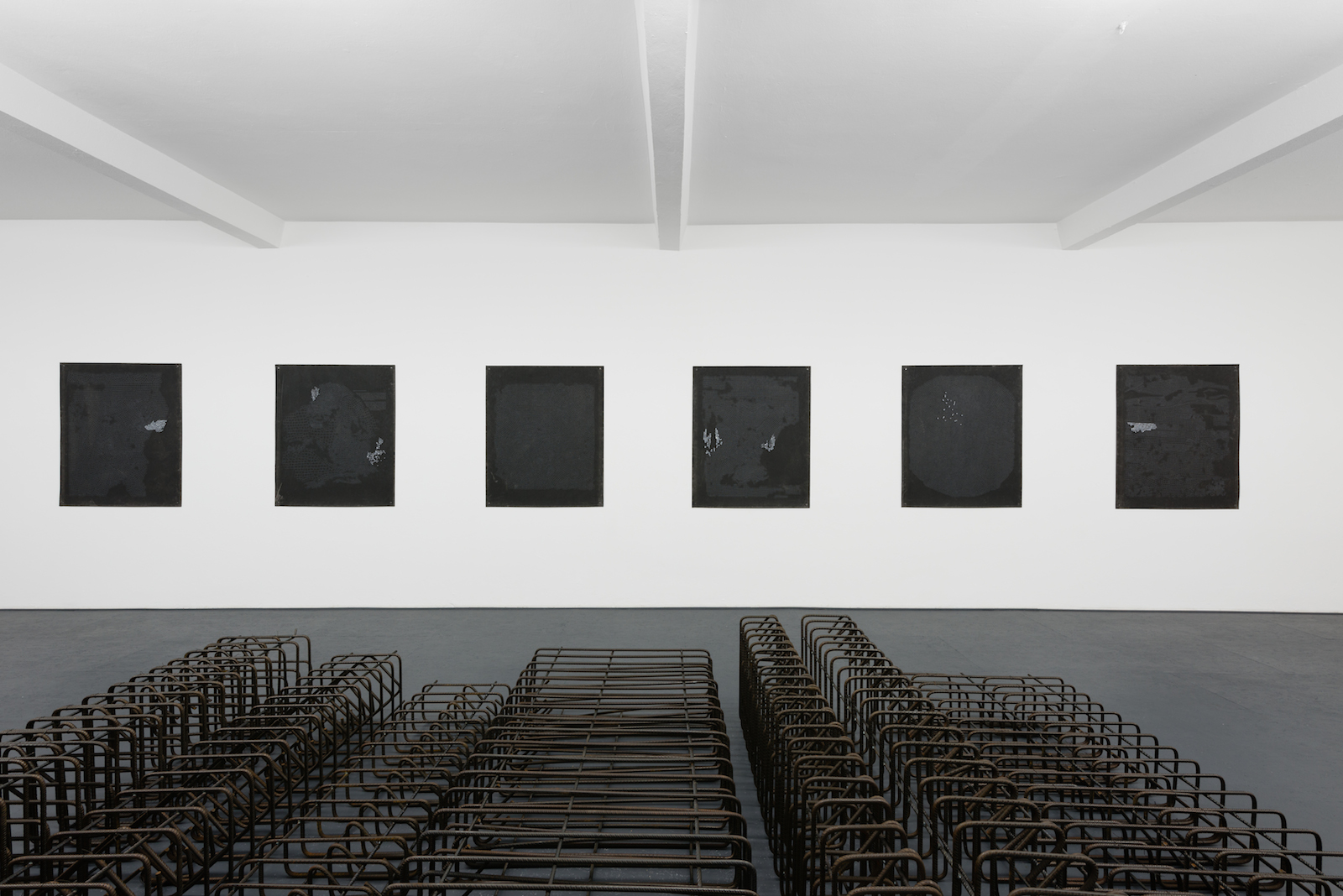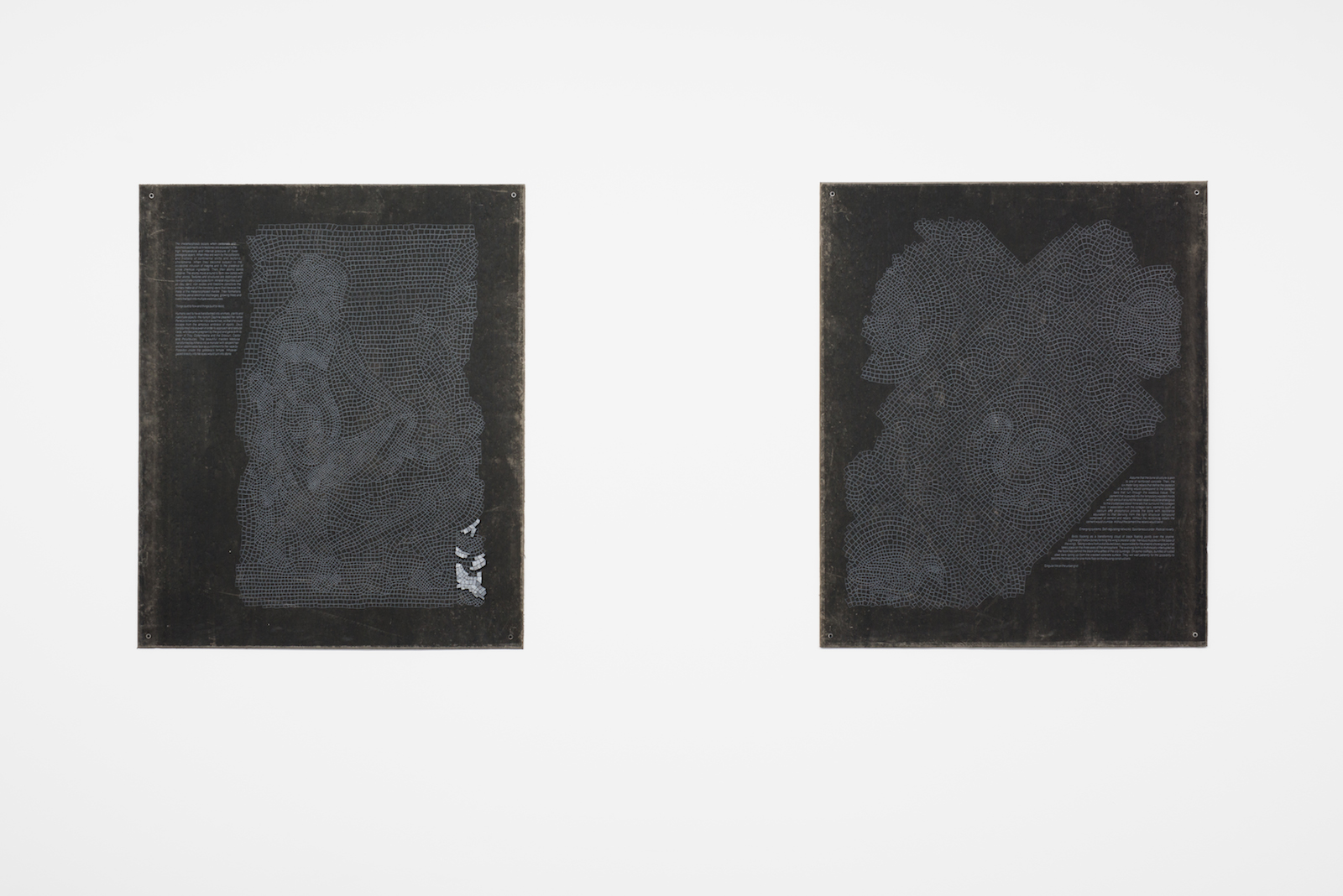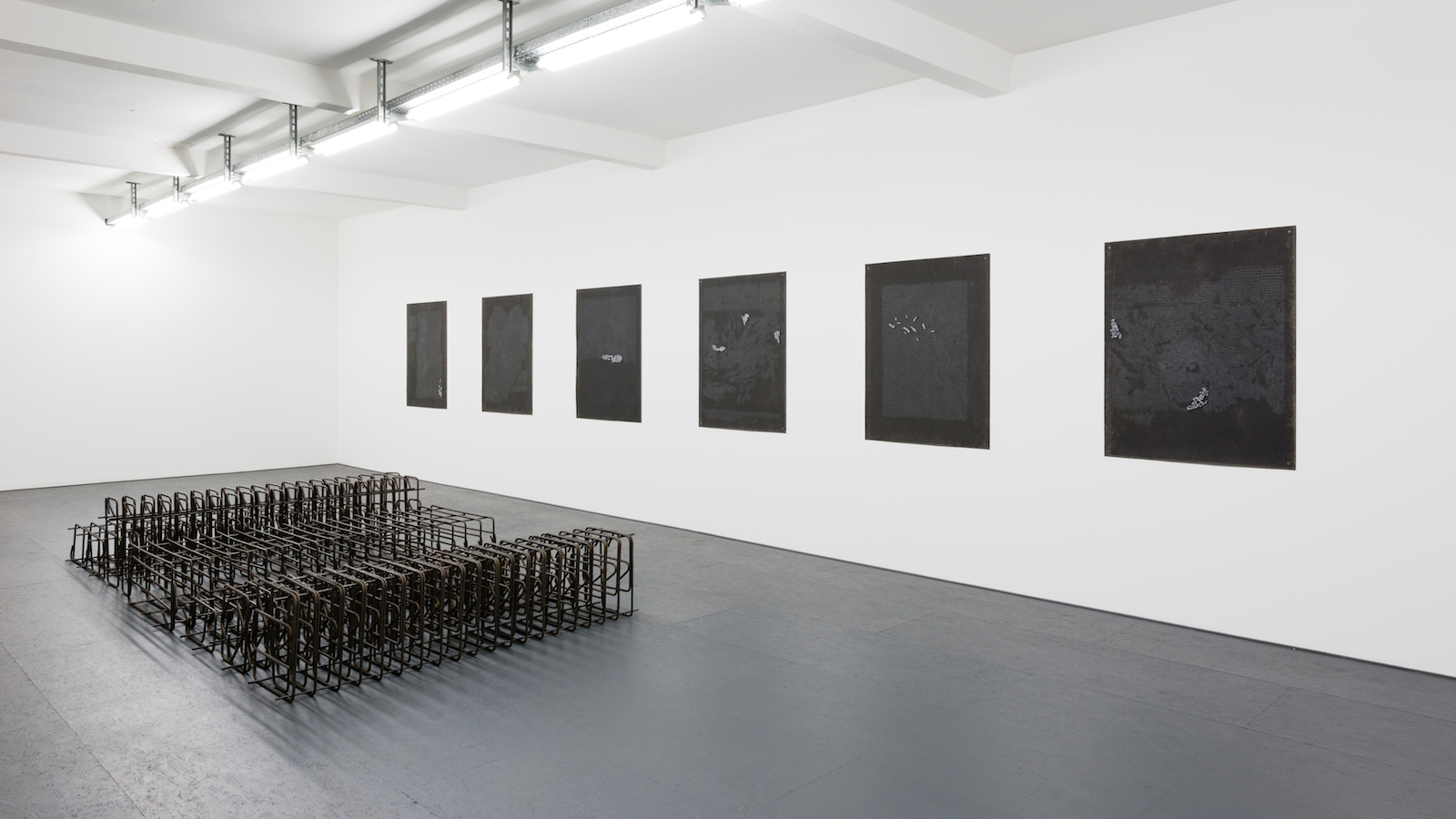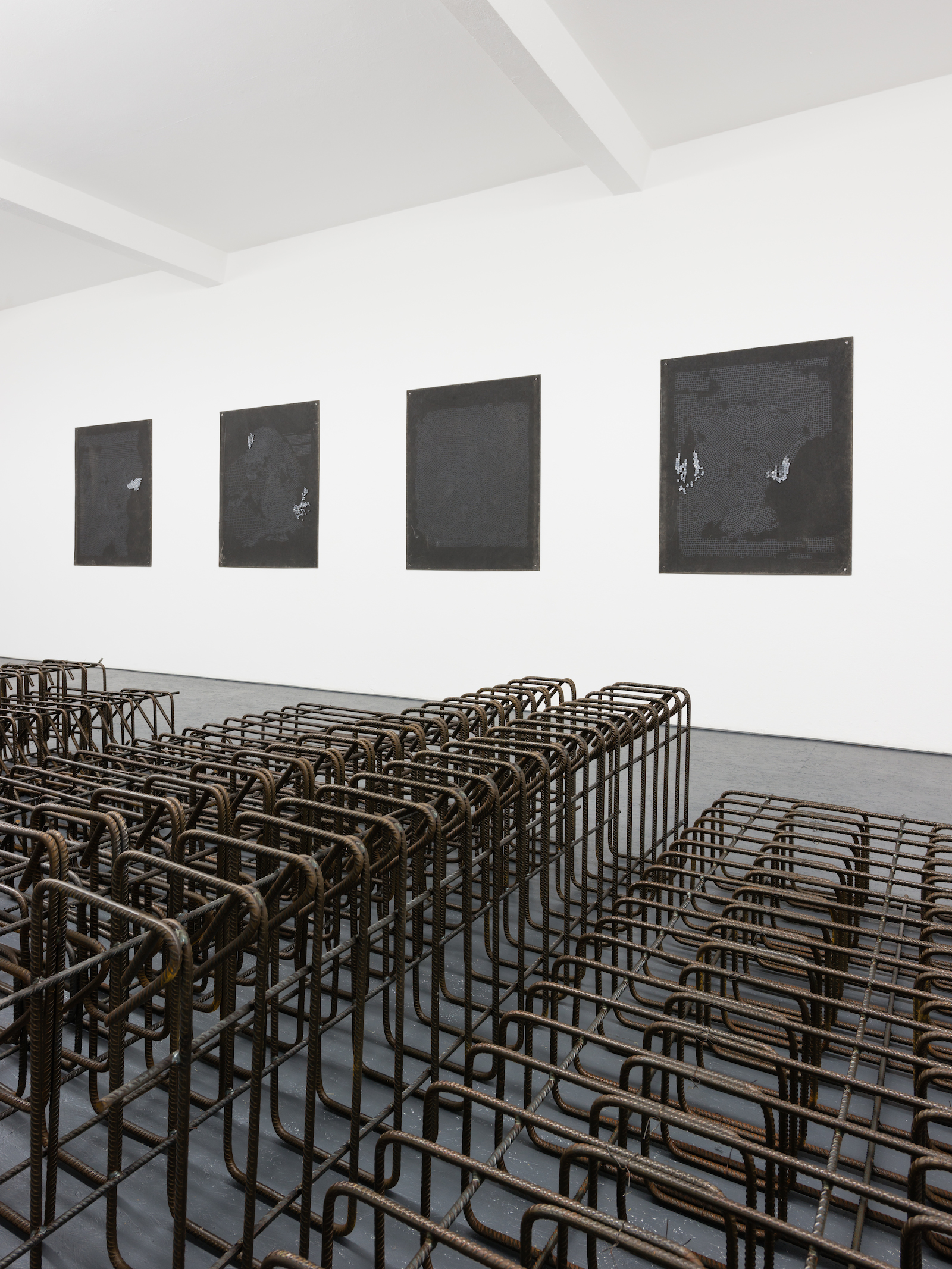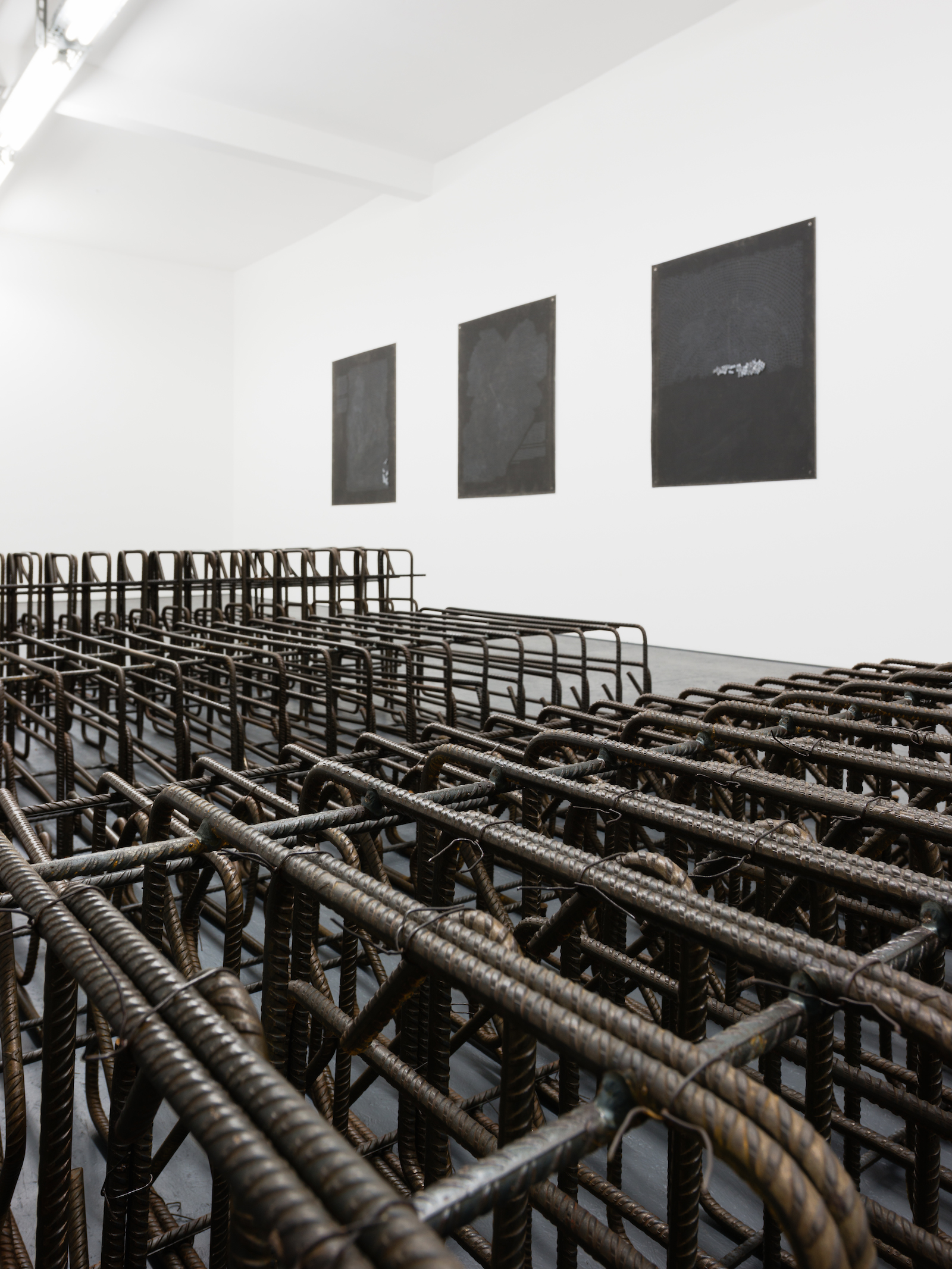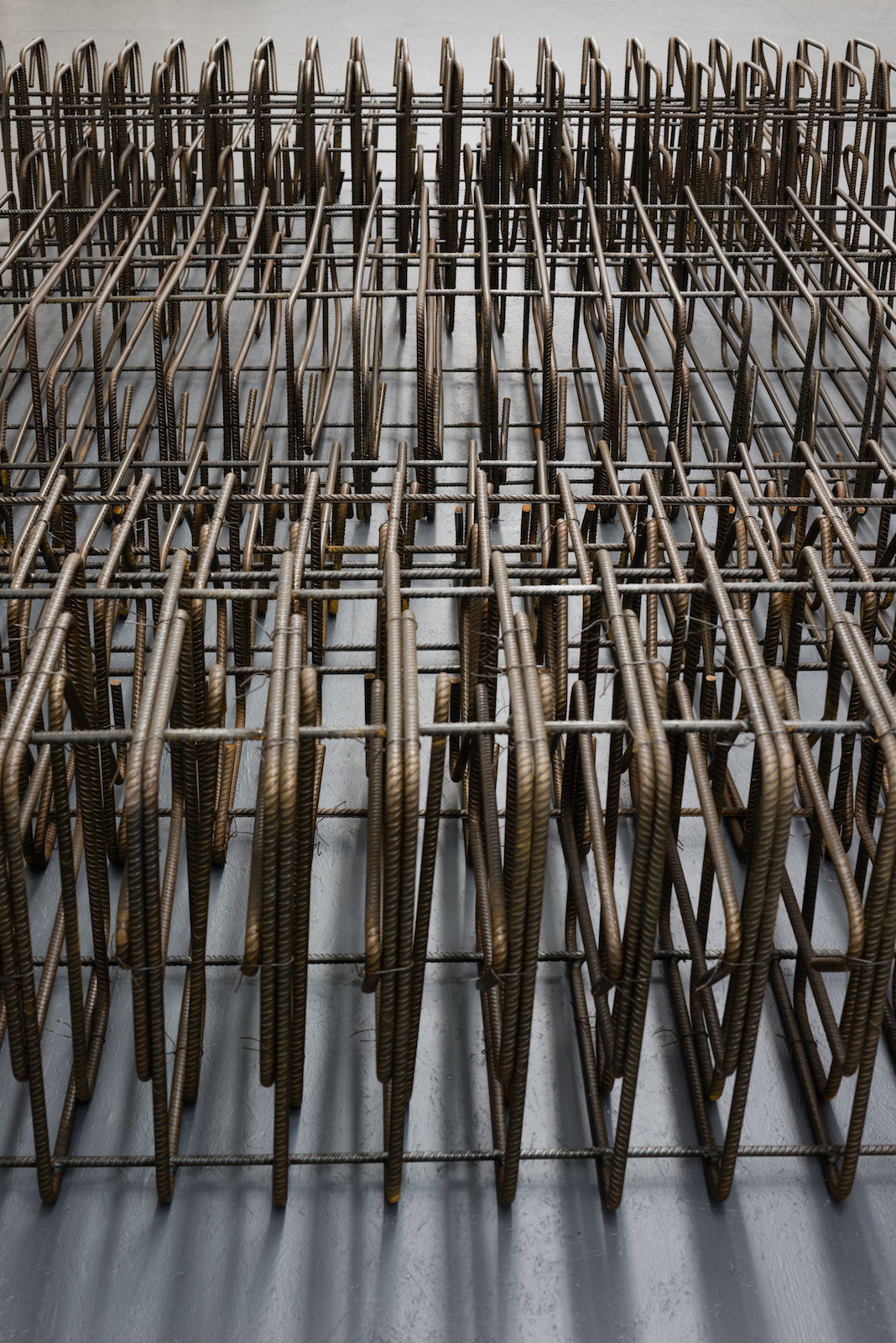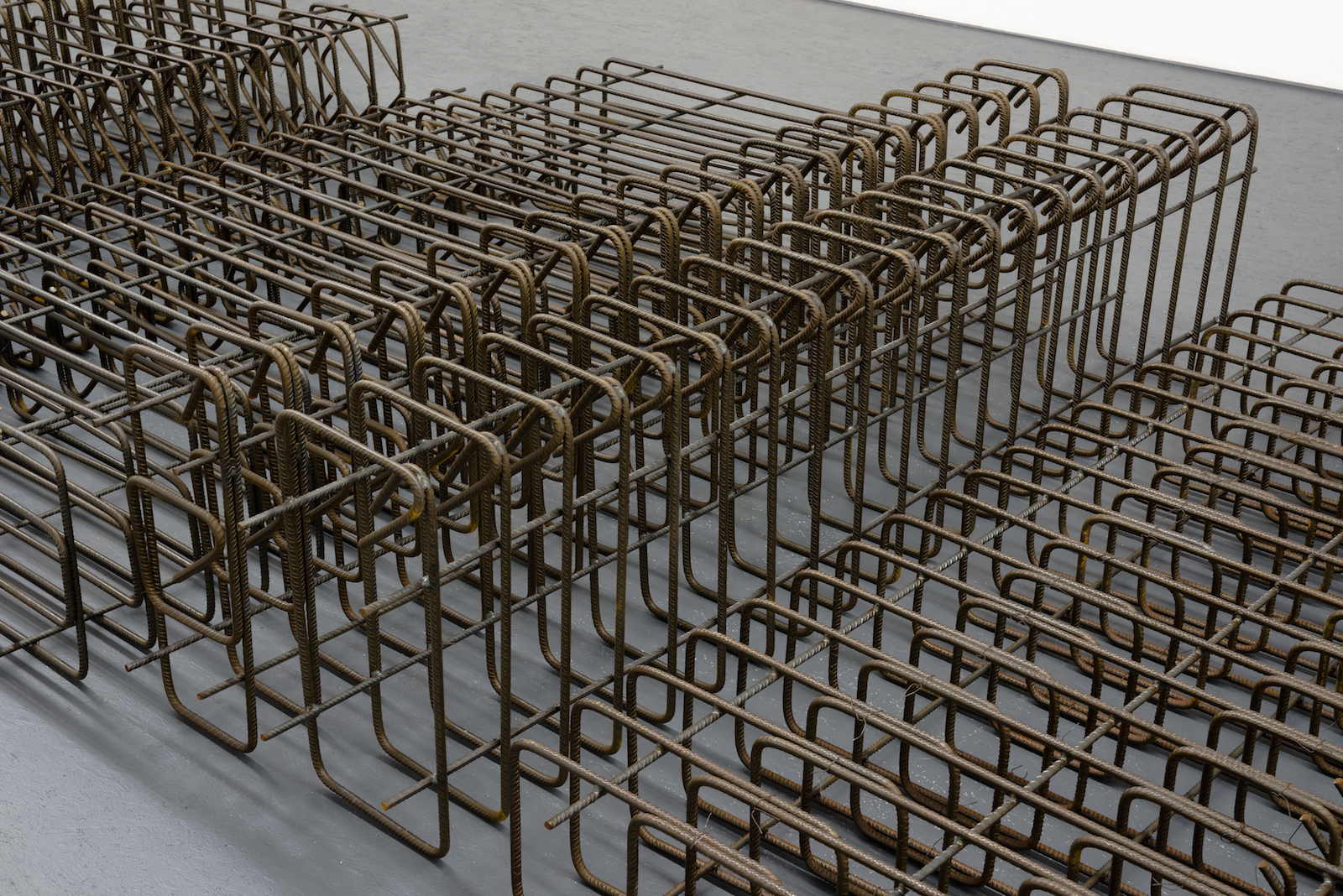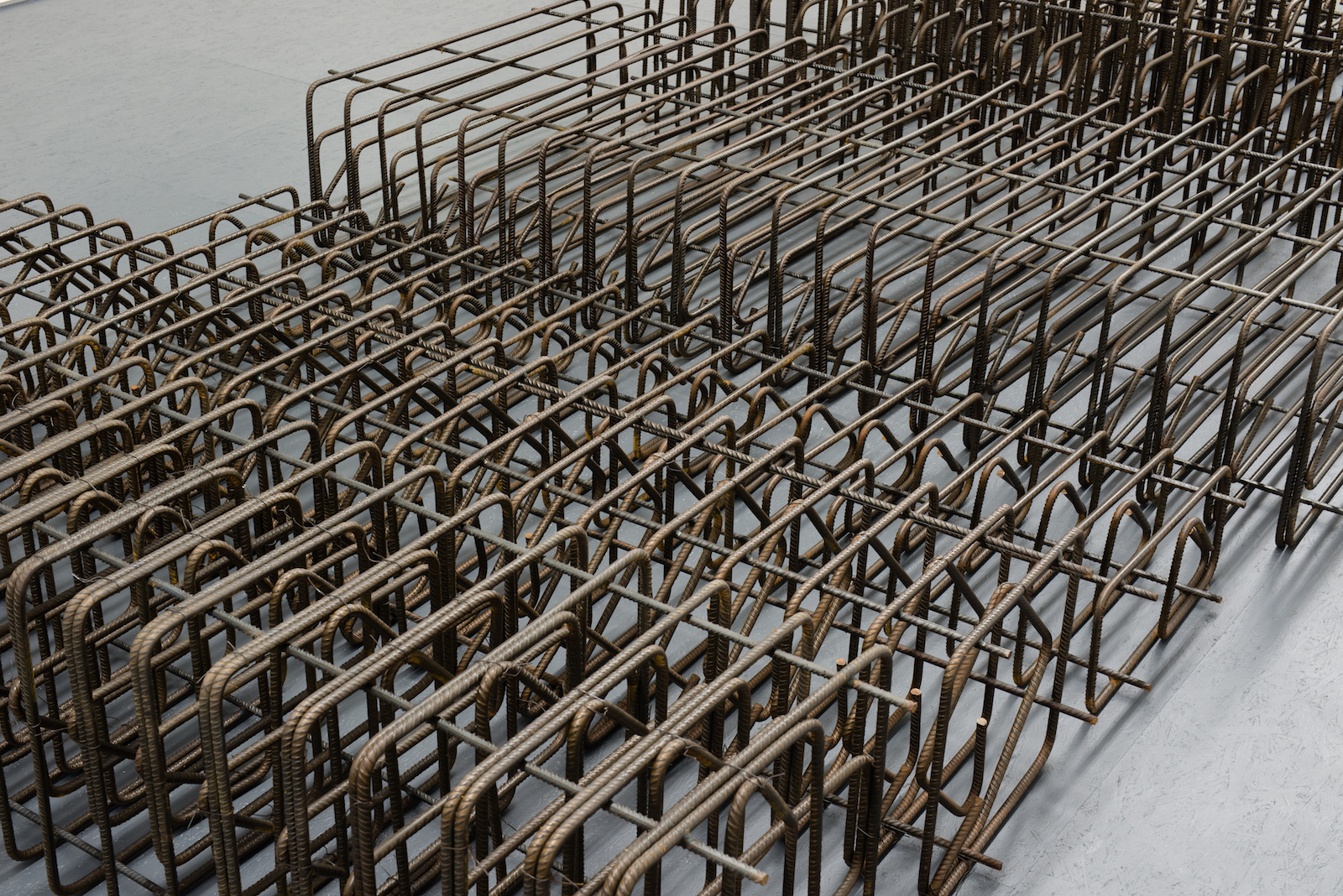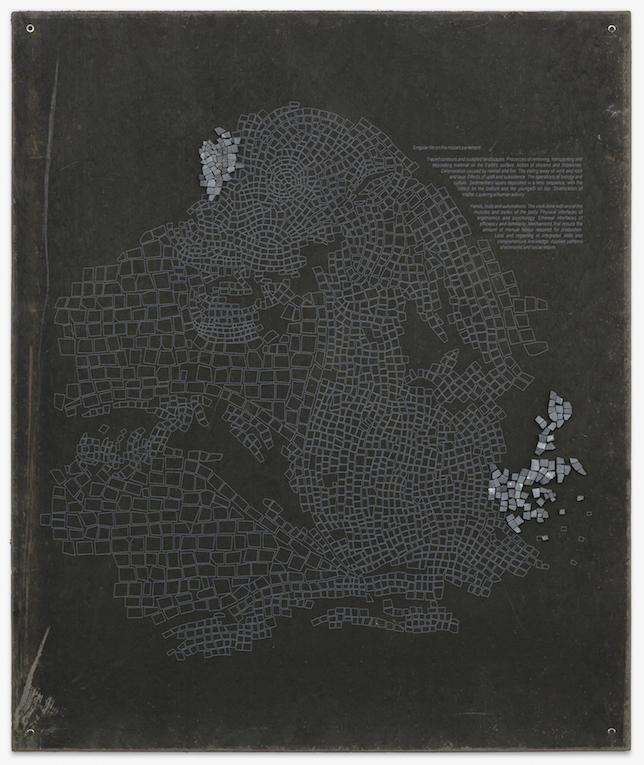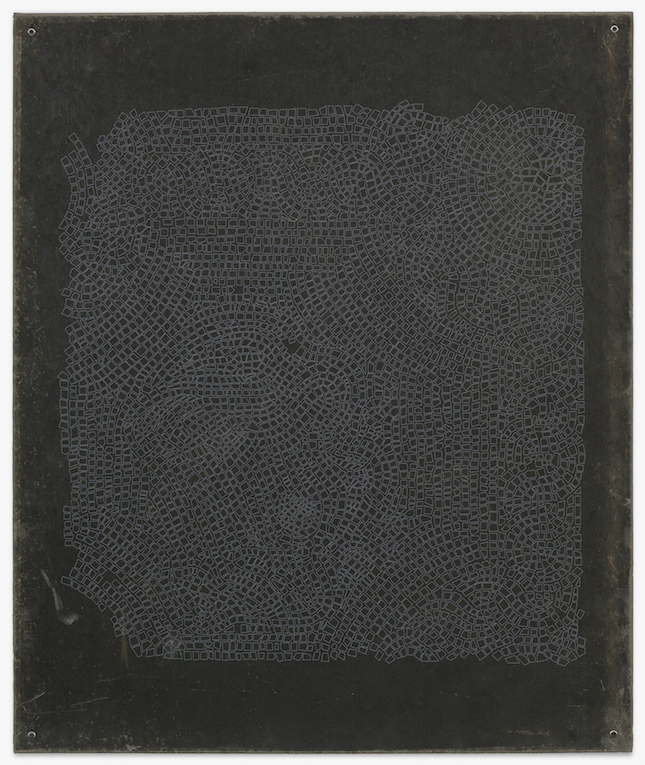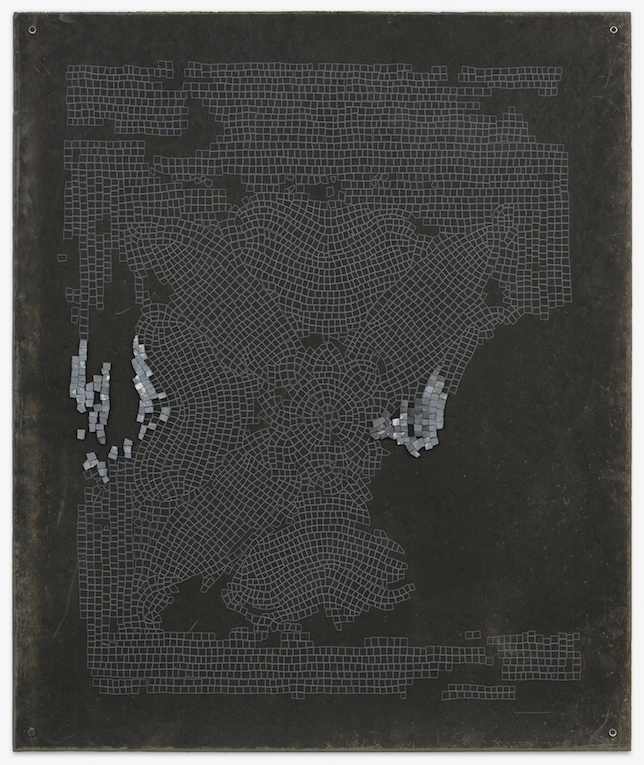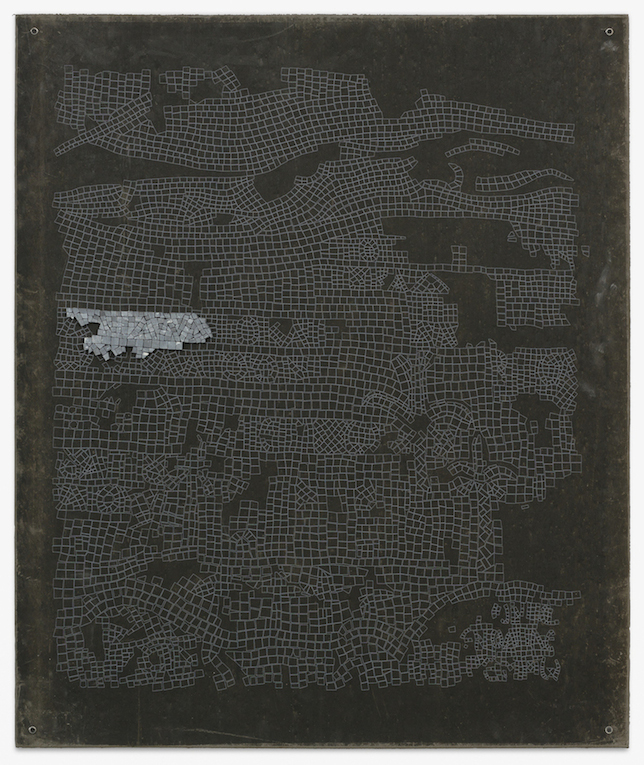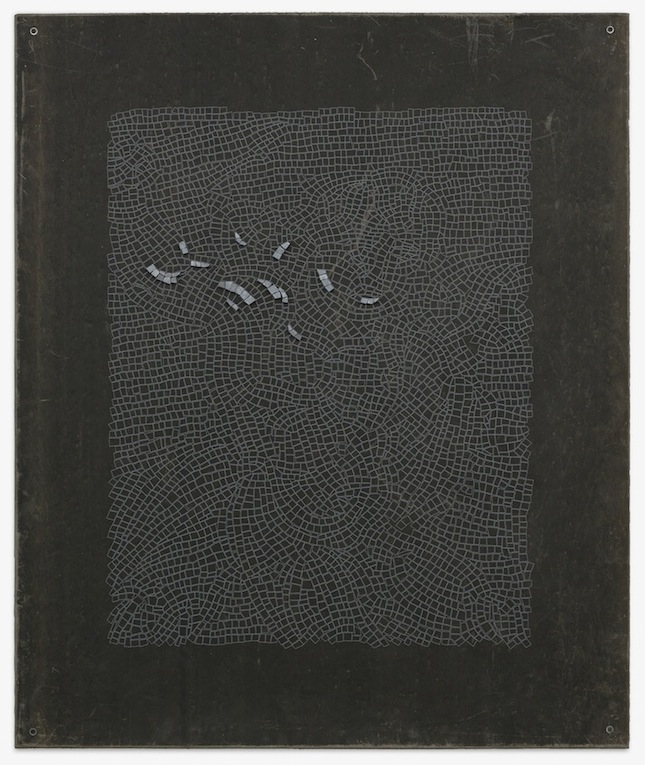PETROS MORIS
IMAGES
INFO
In his first solo show at DUVE Berlin, Athens-based artist Petros Moris presents an installation of wall-based and sculptural works that bring together practices of industrial, digital and manual production, in order to reflect on the historical and material layers that compose the techno-cultural strata of the contemporary human-built environment.
Being the first element of the show, Copies constitutes a series of digital prints on sheets of rubber flooring insulation that use as their primary visual material a selection of ancient mosaic pavements that extend across the Hellenistic, Roman and Byzantine eras, while originating from different cities built around the Mediterranean. These mosaic compositions are manually traced tile-by-tile with the usage of CAD software, rendering an abstract synthesis of digitally-designed tile wireframes. This laborious tracing process eventually strips away representational elements such as colors and tones from the original mosaics’ subjects, which span from decorative, animal and plant motifs, to mythological and folklore scenes. Revealing the bare structure of the diverse tessellation techniques assigned to their respective initial compositions, these black rectangular wall pieces present themselves as hybrids between archeological presentation boards, architectural software interfaces and non-functional building elements. Scattered areas covered with actual marble tiles act as parasitical samples that force themselves onto these fragmented geometrical landscapes. They eventually refer back to the material and labour-related aspects attributed to the selected ancient artefacts.
Operating in dialogue with Copies, the sculptural installation Columns consists of seven different typologies of steel cages, namely pre-made metallic constructions of reinforcing steel. Systematically arranged in rows, the two meter-long metallic forms of various diameters compose a scenery resembling an idle construction site: a place in a state of wreckage or, alternatively, a place to-become.
In *Copies and Columns* Moris employs archeological and preservation analogies in combination with constructional and decorative practices in order to produce a system of spatial and conceptual subversion. The third part of the show, a text written by the artist, is dispersed around the wall pieces as unexpected supporting elements that fill up the ruined empty areas of the wireframe mosaic compositions. Both theoretic and poetic in character, the text traces the movement from the intimate scale of manual gesture to the ones of natural entropic processes and tectonic production by way of an idiosyncratic kaleidoscopic logic.
* * *
Petros Moris was born in 1986 in Lamia, Greece. He completed his studies at the Athens School of Fine Arts and obtained an MFA in Curating from Goldsmiths, University of London. He is currently pursuing a PhD in Architecture at the University of Thessaly, Greece. Moris has exhibited his work in solo shows at Project Native Informant, London (2013), OMMU Distribution, Athens (2011) and Kappatos Gallery, Athens (2010). As one of the founders of the the art collective KERNEL, he has presented work in solo exhibitions at SPACE, London (2013) and XYZ Outlet, Athens (2011). He has curated projects for the Athens Biennial and the London-based project space Woodmill, as well as for the Whitechapel Gallery and the Chisenhale Gallery in London (as part of the SIM collective). Moris is the founder of Athens-based publishing and curatorial project Radical Reading.
Being the first element of the show, Copies constitutes a series of digital prints on sheets of rubber flooring insulation that use as their primary visual material a selection of ancient mosaic pavements that extend across the Hellenistic, Roman and Byzantine eras, while originating from different cities built around the Mediterranean. These mosaic compositions are manually traced tile-by-tile with the usage of CAD software, rendering an abstract synthesis of digitally-designed tile wireframes. This laborious tracing process eventually strips away representational elements such as colors and tones from the original mosaics’ subjects, which span from decorative, animal and plant motifs, to mythological and folklore scenes. Revealing the bare structure of the diverse tessellation techniques assigned to their respective initial compositions, these black rectangular wall pieces present themselves as hybrids between archeological presentation boards, architectural software interfaces and non-functional building elements. Scattered areas covered with actual marble tiles act as parasitical samples that force themselves onto these fragmented geometrical landscapes. They eventually refer back to the material and labour-related aspects attributed to the selected ancient artefacts.
Operating in dialogue with Copies, the sculptural installation Columns consists of seven different typologies of steel cages, namely pre-made metallic constructions of reinforcing steel. Systematically arranged in rows, the two meter-long metallic forms of various diameters compose a scenery resembling an idle construction site: a place in a state of wreckage or, alternatively, a place to-become.
In *Copies and Columns* Moris employs archeological and preservation analogies in combination with constructional and decorative practices in order to produce a system of spatial and conceptual subversion. The third part of the show, a text written by the artist, is dispersed around the wall pieces as unexpected supporting elements that fill up the ruined empty areas of the wireframe mosaic compositions. Both theoretic and poetic in character, the text traces the movement from the intimate scale of manual gesture to the ones of natural entropic processes and tectonic production by way of an idiosyncratic kaleidoscopic logic.
* * *
Petros Moris was born in 1986 in Lamia, Greece. He completed his studies at the Athens School of Fine Arts and obtained an MFA in Curating from Goldsmiths, University of London. He is currently pursuing a PhD in Architecture at the University of Thessaly, Greece. Moris has exhibited his work in solo shows at Project Native Informant, London (2013), OMMU Distribution, Athens (2011) and Kappatos Gallery, Athens (2010). As one of the founders of the the art collective KERNEL, he has presented work in solo exhibitions at SPACE, London (2013) and XYZ Outlet, Athens (2011). He has curated projects for the Athens Biennial and the London-based project space Woodmill, as well as for the Whitechapel Gallery and the Chisenhale Gallery in London (as part of the SIM collective). Moris is the founder of Athens-based publishing and curatorial project Radical Reading.
Copies and Columns ist die erste Einzelausstellung des in Athen lebenden Künstlers Petros Moris bei DUVE Berlin. Er präsentiert eine Installation aus Wandarbeiten und Skulpturen, die unterschiedliche Verfahren industrieller, digitaler und manueller Produktion zusammenbringt, um (über) die historischen und materiellen Ebenen zu reflektieren, aus denen sich die technisch-kulturellen Schichten unserer zeitgenössischen, menschengemachten Umwelt zusammensetzen.
Copies, als das erste Element der Schau, besteht aus einer Reihe von Digitaldrucken auf Gummibodenplatten. Sie sind angelehnt an alte Mosaikböden aus hellenistischer und römischer – bis hin zur byzantinischen Tradition, die aus verschiedenen Städten der Mittelmeerregion stammen. Für diese Mosaik-Kompositionen wird jede einzelne Komponente per Hand (auf der Computermaus), mit Hilfe von CAD-Software abgepaust, wodurch eine abstrakte Synthese digital entworfener Fliesen-Raster entsteht. Den ursprünglichen Darstellungen der Mosaike, auf denen dekorative Tier- und Pflanzenmotive, mythologische oder folkloristische Szenen abgebildet sind, entzieht dieser aufwendige Nachverfolgungsprozess letztendlich die bildlichen Elemente, wie Farbe und Tönung. Zurück bleibt die nackte Struktur der verschiedenen Kachelungstechniken der Ursprungskompositionen. Die schwarzen rechteckigen Wandarbeiten lassen an archäologische Schautafeln, architektonische Software-Schnittstellen oder nicht-funktionale Gebäudeelemente denken. Vereinzelte Felder mit tatsächlichen Marmorplatten wirken aufdringlich parasitär vor dem Hintergrund dieser fragmentiert geometrischen Landschaften. Letztendlich verweisen sie auf die material- und arbeitsbezogenen Aspekte der antiken Artefakte zurück.
Die im Dialog zu den Copies stehende skulpturale Installation Columns besteht aus sieben verschiedenen Stahlkäfig-Typen. Es handelt sich um systematisch in Reihen angeordnete, vorgefertigte Metallkonstruktionen aus Betonstahl. Die zwei Meter langen Metallstangen mit verschiedenen Durchmessern bilden eine Landschaft, die einer Baustelle im Leerlauf ähnelt: einem abgewrackten- oder aber auch einem werdenden Ort.
In *Copies and Columns* bedient Moris archäologische und museale Analogien, kombiniert sie mit baulichen und dekorativen Aspekten und konzipiert so ein System räumlicher und konzeptioneller Subversion. Der dritte Teil der Ausstellung ist ein Text des Künstlers, der rund um die Wandinstallationen verteilt ist. Er fungiert hier als ein unerwartetes, unterstützendes Element, dessen Einzelteile die zerstörten leeren Bereiche der Mosaik-Raster füllen. Der Text ist sowohl theoretischer, als auch poetischer Natur und zeichnet in seiner eigenwilligen, kaleidoskopischen Logik die Bewegung von der intimen Größenordnung einer Handgeste, bis hin zu den gestischen Ausmaßen natürlicher Entropie-Einwirkung und tektonischer Produktion, nach.
* * *
Petros Moris wurde 1986 in Lamia, Griechenland geboren. Er absolvierte sein Studium an der Athens School of Fine Arts und hält einen MFA in Curating vom Goldsmiths College, University of London und arbeitet aktuell an einer Doktorarbeit (PhD) in Architektur an der Universität von Thessalien, Griechenland. Moris hatte Einzelausstellungen bei Project Native Informant, London (2013), OMMU Distribution, Athen (2011) und Kappatos Gallery, Athen (2010). Als einer der Gründer des Künstlerkollektivs KERNEL hatte Moris Einzelausstellungen im SPACE, London (2013) und XYZ Outlet, Athen (2011). Er hat Projekte für die Athen Biennale und dem in London ansässigen Projektraum Woodmill sowie für die Whitechapel Gallery und dem Chisenhale Gallery in London (im Rahmen der SIM Tarif) kuratiert.
Copies, als das erste Element der Schau, besteht aus einer Reihe von Digitaldrucken auf Gummibodenplatten. Sie sind angelehnt an alte Mosaikböden aus hellenistischer und römischer – bis hin zur byzantinischen Tradition, die aus verschiedenen Städten der Mittelmeerregion stammen. Für diese Mosaik-Kompositionen wird jede einzelne Komponente per Hand (auf der Computermaus), mit Hilfe von CAD-Software abgepaust, wodurch eine abstrakte Synthese digital entworfener Fliesen-Raster entsteht. Den ursprünglichen Darstellungen der Mosaike, auf denen dekorative Tier- und Pflanzenmotive, mythologische oder folkloristische Szenen abgebildet sind, entzieht dieser aufwendige Nachverfolgungsprozess letztendlich die bildlichen Elemente, wie Farbe und Tönung. Zurück bleibt die nackte Struktur der verschiedenen Kachelungstechniken der Ursprungskompositionen. Die schwarzen rechteckigen Wandarbeiten lassen an archäologische Schautafeln, architektonische Software-Schnittstellen oder nicht-funktionale Gebäudeelemente denken. Vereinzelte Felder mit tatsächlichen Marmorplatten wirken aufdringlich parasitär vor dem Hintergrund dieser fragmentiert geometrischen Landschaften. Letztendlich verweisen sie auf die material- und arbeitsbezogenen Aspekte der antiken Artefakte zurück.
Die im Dialog zu den Copies stehende skulpturale Installation Columns besteht aus sieben verschiedenen Stahlkäfig-Typen. Es handelt sich um systematisch in Reihen angeordnete, vorgefertigte Metallkonstruktionen aus Betonstahl. Die zwei Meter langen Metallstangen mit verschiedenen Durchmessern bilden eine Landschaft, die einer Baustelle im Leerlauf ähnelt: einem abgewrackten- oder aber auch einem werdenden Ort.
In *Copies and Columns* bedient Moris archäologische und museale Analogien, kombiniert sie mit baulichen und dekorativen Aspekten und konzipiert so ein System räumlicher und konzeptioneller Subversion. Der dritte Teil der Ausstellung ist ein Text des Künstlers, der rund um die Wandinstallationen verteilt ist. Er fungiert hier als ein unerwartetes, unterstützendes Element, dessen Einzelteile die zerstörten leeren Bereiche der Mosaik-Raster füllen. Der Text ist sowohl theoretischer, als auch poetischer Natur und zeichnet in seiner eigenwilligen, kaleidoskopischen Logik die Bewegung von der intimen Größenordnung einer Handgeste, bis hin zu den gestischen Ausmaßen natürlicher Entropie-Einwirkung und tektonischer Produktion, nach.
* * *
Petros Moris wurde 1986 in Lamia, Griechenland geboren. Er absolvierte sein Studium an der Athens School of Fine Arts und hält einen MFA in Curating vom Goldsmiths College, University of London und arbeitet aktuell an einer Doktorarbeit (PhD) in Architektur an der Universität von Thessalien, Griechenland. Moris hatte Einzelausstellungen bei Project Native Informant, London (2013), OMMU Distribution, Athen (2011) und Kappatos Gallery, Athen (2010). Als einer der Gründer des Künstlerkollektivs KERNEL hatte Moris Einzelausstellungen im SPACE, London (2013) und XYZ Outlet, Athen (2011). Er hat Projekte für die Athen Biennale und dem in London ansässigen Projektraum Woodmill sowie für die Whitechapel Gallery und dem Chisenhale Gallery in London (im Rahmen der SIM Tarif) kuratiert.

